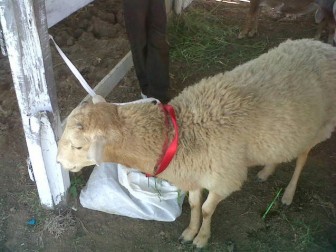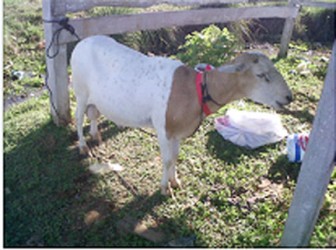Mutton may not be at the top of the list among red meat consumers in Guyana but it has always laid claim to a significant market share of its own. More than that, the fact that mutton, regarded as ‘top end’ meat among consumers, fetches a significantly higher price than other red meats, makes sheep rearing a multi-million-dollar business.
The West Coast Berbice, one of the more popular sheep-rearing regions of the country, has a fair share of the local mutton market. Once a year, tending sheep becomes a preoccupation with several villages along a stretch of the coast.

Last Sunday’s annual Sheep and Goat Competition hosted by the West Coast Berbice Sheep and Goat Association and staged at the Mohan Singh Turf Club Ground provided an opportunity to secure insights into the industry that go beyond determining who, amongst the breeders, raises the best sheep and goats in the community.
Between Profit and Rosignol on the West Coast Berbice, 61 sheep and goat breeders are members of the association. Last Sunday’s competition afforded an opportunity for the efforts of the breeders to come under the critical scrutiny of experts—like the Ministry of Agriculture’s Chief Crops and Livestock Officer Dr Dindyal Permaul—in the disciplines relating to the breeding of livestock.
For all the obvious pride and assertiveness that attends the business of sheep breeding, the association and the farmers on the West Coast Berbice as a whole are hard-pressed to meet the national demand for mutton. At around $1,000 per pound, mutton enjoys a market that is limited to those who can afford it. Still, the breeders in West Coast Berbice struggle to meet the demands of the market.
The association’s Chairman Clyde McAlmont concedes that the group has been unable, over a protracted period of time, to meet set targets. He refers to the association once being set a challenge of supplying up to 1,000 pounds of mutton per week to a section of the local market. At best, it was able to muster 350 pounds.

Dr Permaul’s advice was that the members of the association might have considered splitting the total order into individual quotas in order to avoid significant depletion of stock on the part of individual breeders. But even that, it appears, is beyond the current capacity of the association’s members.
Efficient rearing practices appear to pose a considerable challenge. Most of the association’s members are modest investors and ensuring that the animals are properly housed and fed, encouraging healthy breeding practices, working with the best breeds, minimising the mortality rate among lambs and staving off the dreaded foot rot disease are all costly pursuits.
The members of the association persist purely on account of the significant rewards which success can bring. Phagwah and Christmas are what one farmer describes as “the mutton seasons”.
In 2010, Guyana reportedly produced 100,000 kilogrammes (kg) of mutton. Last year, the amount increased to 167,000 kg. If these amounts seem modest, they do no more than reflect the underdevelopment of the industry.
Without providing actual numbers, Permaul said “a significant portion” of locally produced mutton is bred in Region Five. Approximately one in every two residents of West Coast Berbice reportedly has something to do with livestock breeding. The practice goes back at least a generation.
The association itself was established five years ago and its secretary, Rambhajan Ramlogan said its main objective is to protect the commercial interests of the breeders.

The Sheep and Goat Competition has been around for as long as the association has been in existence. Much of it is about bragging rights, though prizes are awarded in several ‘Best Breeding’ categories. In essence, the event allows for a periodic expert assessment of the state of the industry by the Ministry of Agriculture’s Crops and Livestock Department. This year, Hubert Nicholson, a breeder from Lichfield was a standout among the winners, taking away the ‘Best Foreign Bred Ram’ prize for the fourth successive year.
Efforts to significantly increase local mutton production have led to an aggressive importation of foreign breeds with the support of the Ministry of Agriculture. The local Texana ram derives from the English Texel male and the better known Black belly sheep imported from Barbados. Permaul said the Texana is among the breeds now popular among local breeders. Apart from having proven to be remarkably adaptable, some of the crossbreeds provide up to 50 per cent more mutton than the local breeds.
The breeders are not the only persons who are aware of the lucrative nature of the industry. It is under constant threat both from thieves and from packs of stray dogs that sometimes attack and kill the lambs.
A few of the breeders also invest in goats. Youmattie Seeram is one of five members of the association who rears goats. She inherited the practice from her parents and says it can also offer “a good living”.
One grouse these farmers have is flooding. The drainage system is old and inefficient and they say they have grown tired of the “fair promises”, which the Ministry of Agriculture routinely makes to improve the drainage system. Often after the floodwaters recede several carcasses are left behind.
Meanwhile, the association has done its bit for the breeders. It purchases feed in bulk and meets the costs of transporting it to the region from the city. Its members also benefited from training provided by the Ministry of Agriculture. Very shortly, the association will receive a grant that has become available through the Rural Enterprise and Agricultural Development Project (READ), a programme being executed by the Agricultural Sector Development Unit of the Ministry of Agriculture.
Beyond those forms of support, the organisation is hoping to have access to grazing lands through the Mahaica-Mahaicony-Abary project. In order to strengthen its marketing infrastructure the association is also seeking to acquire a vehicle to transport members’ mutton to market.
The group is a long way from laying claim to the success which it so earnestly seeks. It is a typical example of small-scale investors becoming involved in ventures that are costly to sustain. But perhaps more significantly, it is also a matter of a group of determined entrepreneurs determined to hold on to what they regard as part of their economic tradition.





